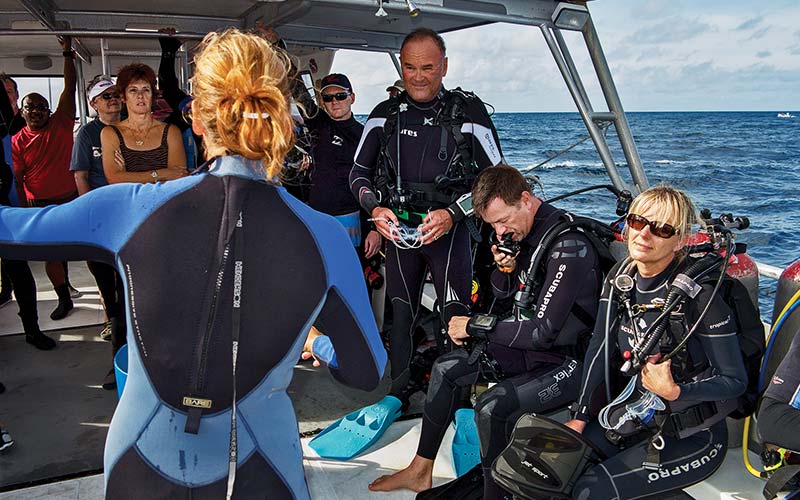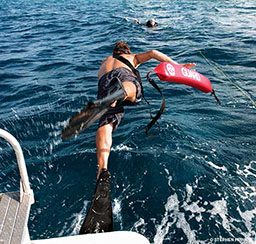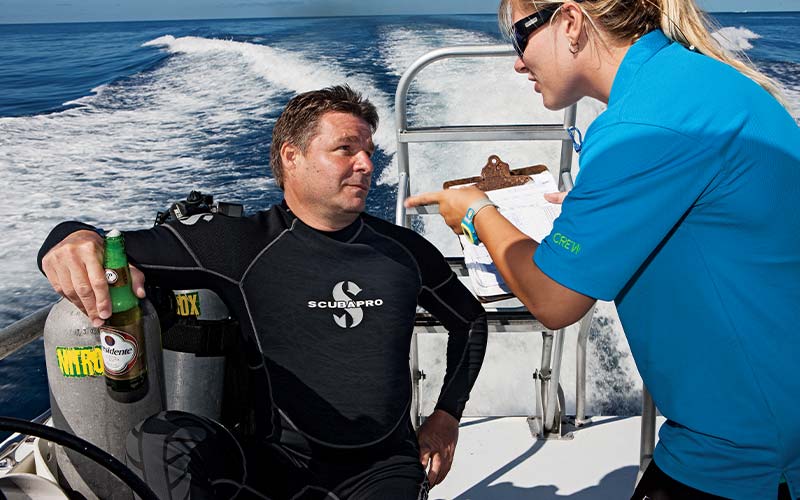Lawsuits are prevalent in modern society, and the diving community is not immune to them. It’s important for both certified divers and dive operators to understand their legal rights and responsibilities. We ask the experts.
Prior to diving, divers are asked to sign a waiver and/or release. What does that document mean for divers, and what kind of protection does it offer for operators?
Michael Steidley: When a diver signs a liability release and assumption-of-risk form, he is acknowledging that he understands the risks inherent to scuba diving and that he releases the operator from responsibility should he be injured or die. Many diving waivers include a statement of safe diving practices and require the diver to review and agree to follow them.
Releases and assumptions of risk in scuba diving have varying degrees of strength. A well-written waiver can help defend an operator in the event of an accident and subsequent lawsuit. With a properly executed and enforceable waiver and release, a plaintiff would typically have to prove gross negligence to win a lawsuit.

Stephen Hewitt: The diver is agreeing in writing not to sue the dive operator for injuries and damages caused by ordinary negligence within the scope of the diving activity. The release is used as a bar to the prosecution of a lawsuit by an injured diver. It may not bar claims for injuries and damages caused by gross negligence or events outside the ordinary scope of diving, such as leaving a diver adrift at sea. References to assumption of risk in the waiver and release agreement are circumstantial evidence that the diver’s injury was due to an inherent risk of the activity. The court determines whether the risk that caused the injury was inherent to scuba diving and could not be prevented without altering the sport.
When the waiver and release agreement are not enforceable, the developing trend is that the trial court will let a redacted version of the waiver and release be shown to the jury as evidence of the diver’s agreement to adhere to safe diving practices, the scope of the diving activities, a testament of fitness to dive and evidence of the diver’s skill and awareness.
David Concannon: The diver is acknowledging that scuba diving involves certain risks and is agreeing to assume those risks — including the risk of injury and death — by engaging in diving. The release is intended to show a judge or jury, who normally are not aware of the risks of diving, that the diver knew and accepted those risks before entering the water. Generally, the protection offered to operators by a signed release is very high, especially if the release is well written and detailed. However, enforceability can vary from jurisdiction to jurisdiction and often from court to court within the same jurisdiction. But more often than not the release is upheld.
What role does the medical statement play in liability cases?
Concannon: The medical statement is critical. Its purpose is to alert the diver to medical conditions that may cause injuries while diving so the diver can seek proper medical attention and advice before engaging in diving. People with medical conditions that may preclude diving often fail to disclose those conditions on the medical statement and then sue the dive professionals after they are injured while diving. I have never seen one of these cases end in favor of the diver.
Hewitt: The medical statement is hugely significant evidence in the defense of the dive operator when it reflects that the diver was fit to dive pursuant to a physician’s statement and/or that the diver concealed a physical condition that was a contraindication to diving. Courts and juries rarely think twice about finding in favor of the dive operator when the injury or death was due to a physical condition concealed by the diver or that was not recognized or considered by the physician to be a contraindication to diving. The medical statement may also help the dive operator’s counsel find additional evidence to establish that a medical condition was related to the injury or death, such as a family history of cardiac problems or sudden death. It also places the responsibility for the fitness to dive on the diver and relieves the dive operator from further responsibility to evaluate the diver’s fitness or health.

What is the duty of the operator and of the certified diver?
Concannon: The duty of the operator is to safely transport the diver to the dive site and ensure the vessel and crew have the necessary safety equipment and procedures on the surface to support a safe experience for the certified diver. The duty of the certified diver is to ensure he personally has the proper gear, training and skills necessary to ensure his own safety underwater. The bottom line: You are responsible for your own safety while diving.
Steidley: Dive operators’ duty to their guests includes but is not limited to following generally accepted diving practices and having equipment that functions properly and safely.

Certified divers need to be both physically and mentally fit to dive and stay within the limits of their training, skill level and certification. Divers should follow standard safe diving practices, including use of the buddy system. Finally, all divers should conduct thorough buddy and equipment checks before every dive.
Hewitt: The dive operator has a responsibility to deliver divers to a location generally commensurate with the skill level of the group, assess the dive-site conditions, have procedures to address emergencies, conduct dive briefings when warranted and organize the diving in a manner consistent with general diving practices.
The duty of the certified diver is to be fit; be current and proficient in his diving skills; be familiar with his gear and confident it’s in working order; dive within the limits of his training, ability and comfort level; adhere to generally accepted safe diving practices; adhere to the dive briefings and, unless expressly agreed upon otherwise, dive with a buddy. The diver must be familiar with the skill level and equipment of his buddy, and there should be an agreed-upon dive plan.
When is it OK for an operator to deny a diver service?
Steidley: It is appropriate for an operator to deny service any time a diver demonstrates unsafe diving practices.
Concannon: The operator should deny service to a diver whenever the operator reasonably believes the diver will be a danger to himself or others. The operator is better off losing a customer than a life. I would rather defend the rare case where a disgruntled diver is suing an operator for failing to provide service than the more common case where a disgruntled family is suing because the operator lost a diver who they allowed to dive despite safety concerns.
Hewitt: A dive operator may deny a diver the opportunity to dive when the operator objectively and reasonably believes the diver poses a danger to himself or his fellow divers. The dive operator cannot deny service on a discriminatory basis.
The consequence of denying service to a diver is that the dive operator may face a breach of contract claim if money is accepted in consideration for the dive trip. Such a claim is highly unlikely (especially when any monetary consideration is returned to the diver). The risk of the dive operator losing a customer is far outweighed by the risk of a lawsuit due to injury of the diver or others. The general consensus of the lawyers defending scuba-diving cases is that it is better for the dive operator to err on the side of caution and avoid unnecessary risks.

What do you consider to be landmark liability cases in the dive community? Why?
Hewitt: In recent years, there have been three landmark scuba diving cases. The first, Barrett v. Ambient Pressure Diving, involved a death related to the use of a rebreather.
In the trial, the jury acknowledged the risks associated with technical diving and readily placed the responsibility on the diver for fully understanding the equipment, ensuring it was working properly and using the equipment correctly during the dive. They did not hold the manufacturer to higher safety standards such as those of automobile or lawnmower manufacturers.

The second, Carlock v. M/V Sundiver, involved a dive boat leaving a diver at the dive site. The court ruled that such an incident was not within the scope of the waiver and release and was not an inherent risk of scuba diving. The jury determined that every one of the dive professionals involved had responsibility for the incident. While the jurors believed the adrift diver had some fault for failing to adhere to the buddy system and the dive briefing, they found it relatively minor in comparison to the fault of the professionals.
The third case, Goetz v. Horizon Charters, involved a claim of negligent rescue in which two divers became separated, and more than 30 minutes passed before a search was initiated to locate the missing diver. The court ruled that the family of the deceased diver must establish gross negligence, because the waiver and release signed by the decedent barred the ordinary negligence claim. In a precedent-setting decision, the court decided that a redacted version of the release could be shown to the jury to demonstrate the deceased diver’s agreement to adhere to safe diving practices (i.e., buddy-diving procedures). The case also highlighted the family’s inability to rule out the possibility that the diver’s underlying health condition played a role in the death and underscored the coroner’s limited ability to determine the cause of the drowning.
Concannon: The recent case of DeWolf v. Kohler, which resulted in a defense verdict in favor of a charter operator to the Andrea Doria wreck, was a landmark decision. The diver died of a heart condition, which he failed to disclose, shortly after entering the water. The diver’s family sued the trip leader, dive boat, a training agency, the diver’s instructor and a scuba equipment manufacturer, alleging that they had a duty to ensure the diver’s safety underwater and seeking $16 million. The practice of technical diving and the concept of accepting personal responsibility were put on trial. The jury found that the trip leader was not responsible for ensuring the diver’s safety underwater and made an additional finding that the diver specifically assumed the risk of his injuries, including death, and he was solely responsible for causing his own death.
Few diving cases ever go to trial, especially when so much money and the practices of an entire industry are at stake. Even fewer result in such an astounding verdict. After the trial the jury specifically told the parties that they wanted their verdict to send the message to not only divers but all people who engage in risky activities that they — and nobody else — are responsible for ensuring their own safety.
Meet the Experts
David Concannon, J.D., is a trial attorney who represents a variety of clients in the dive industry in personal injury, products liability and wrongful death litigation. Concannon investigates a number of scuba fatalities every year and has led panel discussions on accident investigations and scuba fatalities at DAN’s Recreational Diving Fatalities Workshop and Rebreather Forum 3.0 in 2012.
Michael Steidley has served as an expert witness. He is an active PADI Course Director, NAUI Instructor, DAN Instructor Examiner, Visual Cylinder Inspector Instructor Trainer for the Professional Scuba Inspectors Organization and a TDI Instructor Trainer for semiclosed rebreathers, decompression procedures and extended range.
Stephen Hewitt, J.D., a trial lawyer of 30 years, practices in California and Hawaii, representing dive professionals, associations and manufacturers. He has served on industry committees, panels and lectures and writes on dive law, authoring “Survey of Sport and Leisure Waiver and Release Law in the United States” among other works.
NOTE: This article is not intended to provide legal advice regarding any given set of circumstances. Laws vary widely depending on where an accident occurs or the jurisdiction where it is litigated. You should always consult with legal counsel if you believe you have suffered an injury or loss due to the failure of a party to meet a legally required duty of care.
© Alert Diver — Q4 Fall 2013